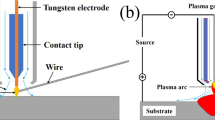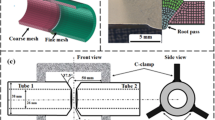Abstract
In this paper, the high-speed clinching named electromagnetic-driven clinching (EMDC) method was adopted and analyzed by experiment, numerical simulation and theoretical calculation. The deformation behavior and mechanical properties of 5052-O EMDC joints have been investigated. The result showed that the punch speed can reach 3 m/s, The maximum strain rate of the EMDC process can reach 6000 s−1. The EMDC process can be divided into deep drawing, interlocking, and unloading stages. The neck thickness tN changes mainly in deep drawing stage. The interlock value tU changes mainly in interlocking stage. The discharge voltage level can precisely control the formation of the joint. With the increase of the discharge voltage, the tN did not change significantly, while the tU increased and mechanical properties of the joint gradually improved. When the discharge voltage was 3.4 kV, the shear and tensile joint strength were 1571 N and 746 N, respectively. The simulation results and the theoretical calculations were in good agreement with the experimental results.
























Similar content being viewed by others
Data availability
All data and materials are fully available without restriction.
References
Zhao X, Zhang J, Chu Y, Cheng P. Research on joining high pressure die casting parts by self-pierce riveting (SPR) using ring-groove die comparing to heat treatment method. SAE Technical Paper. 2020. https://doi.org/10.4271/2020-01-0222.
Deepati AK, Alhazmi W, Benjeer I. Mechanical characterization of AA5083 aluminu-m alloy welded using resistance spot welding for the lightweight automobile body fa-brication. Materials Today Proceedings. 2021. https://doi.org/10.1016/j.matpr.2021.01.646.
Abe Y, Kato T, Mori K. Self-piercing riveting of high tensile strength steel and alu-minium alloy sheets using conventional rivet and die. J Mater Process Technol. 2009;209(8):3914–22. https://doi.org/10.1016/j.jmatprotec.2008.09.007.
Vorderbrüggen J, Köhler D, Grüber B, et al. Development of a rivet geometry for s-olid self-piercing riveting of thermally loaded CFRP-metal joints in automotive cons-truction. Composite Struct. 2022. https://doi.org/10.1016/j.compstruct.2022.115583.
Mori K, Abe Y. A review on mechanical joining of aluminium and high strength ste-el sheets by plastic deformation. Internat J Lightweight Materials M-anufacture. 2018;1(1):1–11. https://doi.org/10.1016/j.ijlmm.2018.02.002.
Eshtayeh MM, Hrairi M, Mohiuddin AKM. Clinching process for joining dissimil-ar materials: state of the art. Internat J Adv Manufacturing Te-chnol. 2016;82:179–95. https://doi.org/10.1007/s00170-015-7363-0.
Zhao L, He XC, Lu Y. Research of mechanical behavior for rounded and rectangul-ar clinched joint. Adv Materials Res. 2014;1035:144–8. https://doi.org/10.4028/www.scientific.net/AMR.1035.144.
Lambiase F, Di Ilio A. An experimental study on clinched joints realized with differ-ent dies. Thin-Walled Struct. 2014;85:71–80. https://doi.org/10.1016/j.tws.2014.08.004.
Fan G, Xue C, Ojo OO, et al. Positional variation of AA5083-H112 and AA6061-T6 alloys: modified friction stir clinching. Vacuum. 2022. https://doi.org/10.1016/j.vacuum.2021.110712.
Barimani-Varandi A, Aghchai AJ, Lambiase F. Failure behavior in electrically-assisted mechanical clinching joints. J Manuf Process. 2021;68:1683–93. https://doi.org/10.1016/j.jmapro.2021.06.072.
Chen C, Ran X, Pan Q, et al. Research on the mechanical properties of repaired clinched joints with different forces. Thin-Walled Structures. 2020. https://doi.org/10.1016/j.tws.2020.106752.
Lee CJ, Kim JY, Lee SK, et al. Design of mechanical clinching tools for joining of aluminium alloy sheets. Materials Design. 2010;31(4):1854–61. https://doi.org/10.1016/j.matdes.2009.10.064.
Kaščák L, Mucha J, Spišák E, et al. Wear study of mechanical clinching dies during joining of advanced high-strength steel sheets. Strength Mater. 2017;49:726–37. https://doi.org/10.1007/s11223-017-9918-9.
Kaščák L, Spišák E, Kubik R, et al. FEM analysis of clinching tool load in a joint of dual-phase steels. Strength Mater. 2016;48:533–9. https://doi.org/10.1007/s11223-016-9795-7.
Lee CJ, Kim JY, Lee SK, et al. Parametric study on mechanical clinching process for joining aluminum alloy and high-strength steel sheets. J Mech Sci Technol. 2010;24:123–6. https://doi.org/10.1007/s12206-009-1118-5.
Lambiase F, Di Ilio A. Joining aluminum with titanium alloy sheets by mechanical c-linching. J Manuf Process. 2018;35:457–65. https://doi.org/10.1016/j.jmapro.2018.09.001.
Xiao A, Lin Y, Huang C, et al. Effect of electromagnetic forming–heat treatment process on mechanical and corrosion properties of 2024 aluminum alloy. J Market Res. 2023;23:1027–38. https://doi.org/10.1016/j.jmrt.2023.01.036.
Babalo V, Fazli A, Soltanpour M. Experimental study of the mechanical performance of the new high-speed mechanical clinching. Inter J Lightweight Mater Manuf. 2021;4(2):218–36. https://doi.org/10.1016/j.ijlmm.2020.11.004.
Salamati M, Soltanpour M, Zajkani A, et al. Improvement in joint strength and mate-rial joinability in clinched joints by electromagnetically assisted clinching. J Manuf Process. 2019;41:252–66. https://doi.org/10.1016/j.jmapro.2019.04.003.
Su H. Research on the FLD and uniaxial tensile behaviour of 5A02 Aluminium Alloy Sheet in the Electromagnetic Pulse Forming (Master Thesis). Harbin, CHN: Harbin Institute of Technology, 2013. https://kns.cnki.net/KCMS/detail/detail.aspx?dbname=CMFD201401&filename=1014003668.nh.
Nourani SA, Stilwell G, Pons DJ. Shear testing of clinch joints at different temper-atures: Explanation of the failure sequence. J Adv Joining Process. 2023. https://doi.org/10.1016/j.jajp.2023.100140.
Zhang X, Chen C. Experimental investigation of joining aluminum alloy sheets by st-epped mechanical clinching. J Market Res. 2022;19:566–77. https://doi.org/10.1016/j.jmrt.2022.05.046.
Qin D, Chen C. Research on the mechanical property and failure mechanism of the d-ieless clinched joints of various aluminum alloys. Eng Fail Anal. 2022. https://doi.org/10.1016/j.engfailanal.2022.106384.
Shi C, Li H, Chen C, et al. Experimental investigation of the flat clinch–rivet process-s. Thin-Walled Structures. 2022. https://doi.org/10.1016/j.tws.2021.108612.
Gao X, Chen C, Ren X, et al. Investigation on failure mechanism of the square clinched joints with different sheet thicknesses. Eng Failure Analysis. 2022. https://doi.org/10.1016/j.engfailanal.2021.106013.
Xu H, Zhang Y, Peng R, et al. Simulation and experimental study on the strength of Al7075-T6 clinched joint. Eng Fail Anal. 2021. https://doi.org/10.1016/j.engfailanal.2021.105735.
Kam H, Wang C, Tan Y, et al. Feasibility of forming aluminium-polymer clinched j-oint with round grooved clinch set. Adv Material Sci Eng: Selected Articles ICMMPE. 2020;2021:376–81. https://doi.org/10.1007/978-981-16-3641-7_46.
Zhang Y, He X, Wang Y, et al. Study on failure mechanism of mechanical clinching in aluminium sheet materials. Internat J Adv Manuf Tec-hnol. 2018;96:3057–68. https://doi.org/10.1007/s00170-018-1734-2.
Liu F, He X, Gu F, et al. A comparative study of local heat treatment for enhancing overall mechanical properties of clinched joints. J Mater Eng Perform. 2021;30:1347–55. https://doi.org/10.1007/s11665-020-05446-w.
Zhang Y, He X, Zeng K, et al. Influence of heat treatment on mechanical properties of clinched joints in titanium alloy sheets. Internat J Adv Manuf Technol. 2017;91:3349–61. https://doi.org/10.1007/s00170-017-0019-5.
Zhang Y, Xu H, Peng R, et al. Joinability and mechanical properties of clinched join-ts of different aluminum alloys. Internat J Precision Eng Manuf. 2021;22:1883–96. https://doi.org/10.1007/s12541-021-00582-2.
Lee CJ, Lee SK, Kim BM, et al. Failure mode dependent load bearing characteristics of mechanical clinching under mixed mode loading condition. Procedia Eng. 2017;207:938–43. https://doi.org/10.1016/j.proeng.2017.10.855.
Funding
This work was supported by the National Natural Science Foundation of China (Grant No: 52275394), and the Project of State Key Laboratory of High-Performance Complex Manufacturing, Central South University (ZZYJKT2020-02).
Author information
Authors and Affiliations
Contributions
CH: methodology, investigation, writing—original draft, YJ: simulation, experiments, writing original draft, XC: methodology, investigation, writing—review and editing, funding acquisition, XS: investigation, collected data, experiments, SW: experiments, HY: experiments.
Corresponding author
Ethics declarations
Conflict of interest
The authors declared that they have no conflicts of interest to this work. We declare that we do not have any commercial or associative interest that represents a conflict of interest in connection with the work submission.
Ethical approval
This article does not contain any studies with human participants performed by any of the authors.
Additional information
Publisher's Note
Springer Nature remains neutral with regard to jurisdictional claims in published maps and institutional affiliations.
Rights and permissions
Springer Nature or its licensor (e.g. a society or other partner) holds exclusive rights to this article under a publishing agreement with the author(s) or other rightsholder(s); author self-archiving of the accepted manuscript version of this article is solely governed by the terms of such publishing agreement and applicable law.
About this article
Cite this article
Huang, C., Ji, Y., Cui, X. et al. Deformation behavior and mechanical properties of 5052-O aluminum alloy joints formed by high-speed clinching. Archiv.Civ.Mech.Eng 23, 152 (2023). https://doi.org/10.1007/s43452-023-00691-x
Received:
Revised:
Accepted:
Published:
DOI: https://doi.org/10.1007/s43452-023-00691-x




